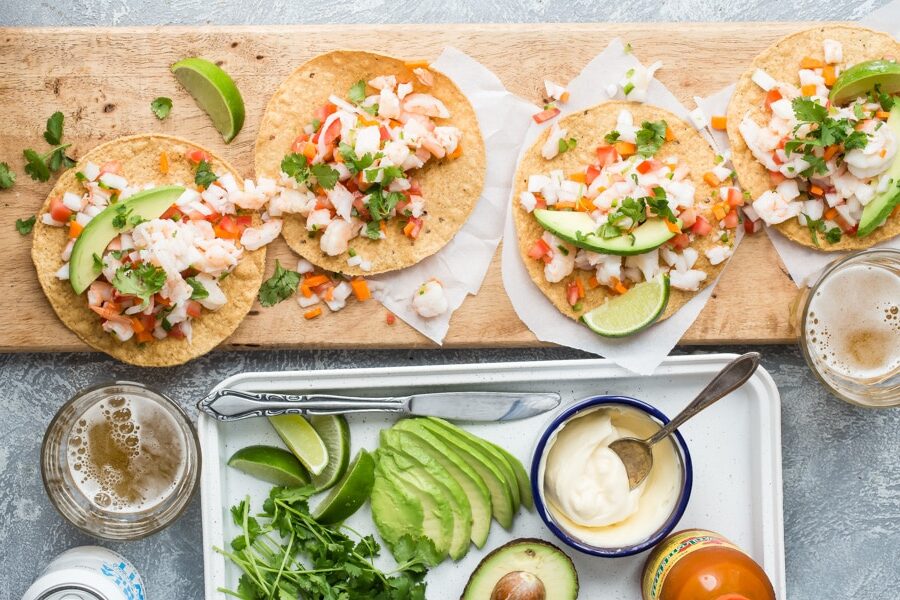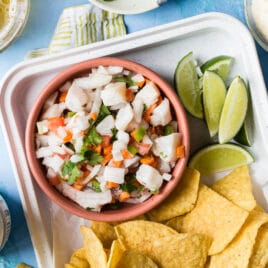Learn how to make ceviche, a zesty fresh fish and citrus salad enjoyed throughout Mexico and South America. It’s so light and irresistibly delicious, you’ll be hooked from the very first bite.
The town of San José de Gracia in Aguascalientes is where I learned how to make ceviche. This is where the famous Cristo Roto is born. But the biggest lesson was that ceviche is different everywhere you go.
Consider this a starting point for your own ceviche recipe. Make it like mine, or make it your own. There are infinite recipes and also no real recipe, so feel free to get creative!.
At a Glance: Here is a quick snapshot of what ingredients are in this recipe. Please see the recipe card below for specific quantities.
Ceviche, the popular Latin American dish of raw fish cured in citrus juice, is a refreshing appetizer perfect for hot summer days. However, preparing ceviche comes with some safety concerns given the raw fish. This leads many home cooks to wonder: is it safe to use frozen fish for ceviche?
The answer is not so straightforward. While freezing fish can kill parasites, the quality of the end result depends heavily on properly handling the fish before freezing. Let’s explore the nuances in detail.
How Ceviche Works
First, it helps to understand how ceviche “cooks” the fish without heat The citrus juice denatures proteins on the surface of the fish, effectively “cooking” it without heat. Fish is typically diced into small pieces to maximize surface exposure to the acidic marinade
However ceviche does not cook fish as thoroughly as heat does. The interior of the fish essentially remains raw. Parasites and bacteria deep within the flesh remain active. So ceviche carries higher risks than cooked fish dishes.
Freezing for Parasite Control
Parasitic worms are a prime concern with raw fish. Species like cod, salmon, and halibut frequently harbor roundworms. Freezing fish properly kills these parasites.
Fish must reach -4°F for 7 days to eliminate parasites. Most home freezers only cool to 0°F, insufficient for parasite destruction. Commercial flash freezing is ideal bringing fish far below -4°F in seconds.
If using home-frozen fish, verify your freezer temperature reaches sufficient coldness. Even then, parasite risks are not fully eliminated if the fish was not handled optimally before freezing.
Start with Fresh High-Quality Fish
Ideally, fish destined for ceviche is:
- Caught wild, not farmed
- Bled immediately upon catching
- Quickly iced or refrigerated
- Promptly eviscerated
This prevents parasites from migrating into the flesh as the fish expires. Blood left in the flesh breeds bacteria. Intact viscera leak enzymes that degrade flesh quality.
Starting with the highest quality ultra-fresh fish minimizes, but does not eliminate, risks before freezing. Verify any frozen fish you purchase was optimally handled prior to freezing.
Texture and Flavor Concerns
Freezing also affects ceviche texture and flavor. Ice crystal formation degrades the flesh structure. Thawing releases liquid, resulting in a mushier end texture. Flavor compounds breakdown during freezing.
Thaw frozen fish gradually in the refrigerator, not at room temperature. This preserves texture better. Cut the fish into uniform small dices for even acid penetration. Marinate for less time than fresh fish to prevent over-softening.
Firm fleshed fish like tuna and halibut hold up better than softer types like cod or salmon.LEANERwhite fish is preferable to fatty fish, as the high oil content becomes rancid with freezing.
Safe Handling of Thawed Fish
Once thawed, treat the fish as you would fresh raw fish:
- Keep chilled at all times, never above 40°F
- Prevent cross-contamination by separating from other foods
- Use clean cutting boards, utensils, and gloves
- Avoid contact between raw fish and cooked foods
Clean all surfaces thoroughly that touch the thawed fish before and after working with it. Discard any flesh that turns mushy or discolors during thawing or prep.
Weighing the Pros and Cons
Frozen fish offers convenience, especially for those without access to fresh fish markets. But it requires meticulous handling and freezing methods to minimize risks.
Thawed frozen fish can deliver acceptable ceviche, but may compromise slightly on flavor and texture versus fresh. Heat sensitive components like citrus zest and herbs are best added just before serving, not during the thawing marinade step.
Here are some other tips for successfully using frozen fish in ceviche:
- Stick to tuna, halibut, snapper, and other firmer lean fish
- Verify freezing temperature and duration met safety standards
- Thaw slowly in the refrigerator
- Handle thawed fish carefully to prevent contamination
- Cut into small uniform dice
- Marinate for less time than fresh fish
- Add herbs and citrus zest fresh before serving
With proper precautions, thawed frozen fish can make suitable ceviche for the home cook. But sourcing ultra-fresh high-quality fish and freezing it yourself is still the best option for optimal safety and quality. Take care in handling to mitigate risks either way.
Do Parasites Pose a Real Threat?
While home ceviche increases parasite risks over cooked fish, the actual danger is quite low statistically in developed countries. Proper fish freezing processes kills most worms and larvae.
For individuals with healthy immune systems, ingesting parasitic worms rarely causes serious illness or lasting complications. At worst, symptoms resemble typical food poisoning: digestive upset, diarrhea, vomiting, cramps.
However, some high-risk groups could develop severe infections from parasites. This includes young children, elderly, pregnant women, and immunocompromised individuals. These groups should avoid undercooked or raw fish including ceviche.
Practice common sense precautions and sourcing high-quality fish helps minimize an already low danger of parasitic illness from homemade ceviche.
Basic Ceviche Precautions
Here are some good general food safety practices for preparing ceviche at home:
- Use sushi-grade fish purchased from reputable sellers
- Freeze fish yourself at home under proper conditions
- Completely thaw frozen fish before marinating
- Work cleanly with sanitized equipment and gloves
- Marinate and serve ceviche chilled below 40°F
- Only marinate thick fish pieces for 2 hours maximum
- Discard any fish with off odors or unusual appearance
- Consume ceviche promptly within the same day it is made
- Avoid ceviche if pregnant or have a compromised immune system
What Fish Work Best for Ceviche?
Stick with well-frozen or sushi-grade fish choices like:
- Tuna
- Salmon
- Halibut
- Snapper
- Sea bass
- Scallops
- Shrimp
Avoid fish from the cod family or freshwater fish which tend to harbor more parasites. Fatty fish like salmon and tuna hold up better to freezing than lean white fish.
No matter what frozen fish you use, handle it properly when thawing, prepping, and marinating to make your ceviche both delicious and safe to eat. Be especially diligent if serving to those at higher risk of illness.
Freezing fish helps control parasites, but frozen ceviche still carries some degree of risk over cooked fish dishes. Texture and flavor also suffer compared to fresh fish ceviche.
With fastidious handling, thawed frozen fish can make tasty ceviche, but consider it a trade-off between safety and quality on one hand versus convenience on the other. Resource ultra-fresh high-quality fish whenever possible, employing freezing as a secondary option.
Proper practices significantly reduce the already small risks of parasitic illnesses from ceviche, even made with frozen fish. But remember home ceviche always carries some low level of risk compared to cooked fish. Weigh your individual health factors and risk tolerance when deciding whether to indulge in this refreshing appetizer.

Recipe tips and variations
- Safety: either commercially frozen fish or high-quality fresh fish for ceviche. Citrus juice does not kill bacteria or parasites in fish, and neither will your home freezer. Cod, swordfish, and many freshwater fish are prone to parasites.
- Yield: This recipe will make about 4 cups ceviche.
- Storage: Store leftovers covered in the refrigerator for 1 day. Ceviche is best enjoyed the day you make it.
- What does the acid in citrus juice do to the proteins in the muscle fibers of fish or seafood? The process is called denaturation.
- Avocado: Adding avocado to ceviche, either mixed in or on top, cools it down and gives it a creamy texture. Guacamole is a great option, too.
- More mix-ins: Get creative with jicama, cucumber, or even pineapple.
- Details about the food’s nutrition will depend on the type of seafood used. This is the label for Tilapia Ceviche (no chips, crackers, or sauces). Instead, a 1-cup serving of Salmon Ceviche has about 200 calories and a 1-cup serving of Shrimp Ceviche has about 140 calories.

Fish and Seafood Recipes
Fish and Seafood Recipes
Fish and Seafood Recipes

What Smart Chefs Know About Frozen Fish
Can you make ceviche with raw fish?
With really good fish, ceviche is one of the most delicious things you can make. All you have to do is cut the raw filleted fish into small, bite-size chunks; refrigerate it for a few minutes to a few hours in an acidic marinade (usually involving lime juice) to “cook” the fish; and then serve.
Is ceviche a bad idea?
A Peruvian invention, the original ceviche recipe is fish or seafood marinated in citrus juices, which then “cook” the fish. I’ve seen all sorts of versions served in restaurants, and if you look on any angler’s forum you’ll see recipes for ceviche of… well anything, really. This can be a very bad idea.
What makes a good ceviche?
“A good ceviche first starts with picking the right fish,” he told us. “You should look for a fish that is white, lean, and flaky. Fish like salmon or halibut won’t work because of its high fat content.” Typical white, lean, and flaky fish include flounder, red snapper, bass, grouper, rockfish, and sole.
Can you eat ceviche raw?
This can be a very bad idea. The reason is because ceviche (sev-ee-chay) is still, for the most part, a raw fish dish. The citrus bath the fish or seafood sits in does turn the meat opaque, giving it the appearance of being cooked, and it does kill some of the many wee beasties present in raw foods that can make you sick, notably the toxin vibrio.
